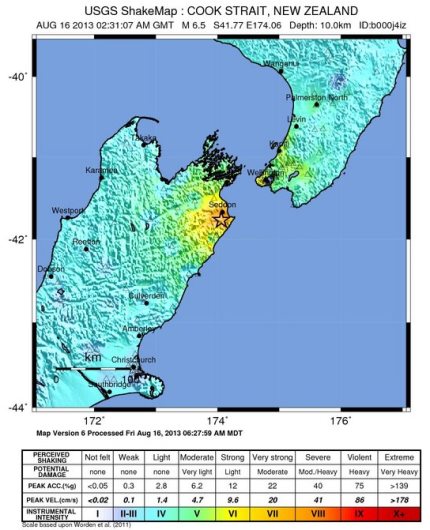South Island Earthquake, New Zealand
Status: Closed
| Type of posting | Posting date(EST): | Summary | Downloads |
|---|---|---|---|
| First Posting | 8/16/2013 1:30:00 PM |
|
First Posting | Summary
Posting Date: August 16, 2013, 1:30:00 PM
Central New Zealand Shaken by Another M6.5 Earthquake
Homes and roads in central New Zealand were damaged by a M6.5 earthquake on Friday, August 16, at 14:31 local time (02:31, UTC), but no serious injuries have been reported. The region has experienced several small- to-moderate sized earthquakes in recent weeks, including one event of M 6.5. These have all occurred in the Cook Strait, which separates New Zealand’s North and South Islands. The epicenter of Friday’s event however, was on land, 10 km (6 m) south-east of the South Island town of Seddon.
The earthquake was felt as far away as Christchurch, 240 km (150 m) south west, and Auckland, 404 km (250 m) north, and there have been several aftershocks of M5.0 or more.
ShakeMap of the M6.5 New Zealand Earthquake of August 16, 2013 (Source: USGS)
Exposure at Risk and Reported Damage
The event was felt strongly in Wellington, some 80 km (50 m) from the rupture. Items jiggled off shelves, some buildings were evacuated and a few people were left trapped in elevators. Train service to the capital was suspended and highways jammed as people left the city early.
In Seddon, a small town of about 450 people, several homes suffered cracks, fallen chimneys and collapsed roofs. More than 20 residents planned to spend the night in an emergency welfare center set up in the school, while others made alternative arrangements. An earth dam near the town, cracked during an earlier quake and in the process of being emptied over concerns about its safety, was further damaged. Landslides (rockfall) and a damaged bridge closed State Highway 1 between Blenheim and Seddon, but Marlborough Airport remained open, with departures running about 20 minutes behind schedule. Regionally, power was cut to about 2,500 homes but was quickly restored.
Seismic design codes in New Zealand have set stringent requirements for new buildings and Wellington has initiated a comprehensive policy to identify earthquake prone pre-1976 buildings and seismically rehabilitate and strengthen them. In this region, as elsewhere, non-engineered unreinforced masonry buildings are the most vulnerable structures. At least one of the homes severely damaged in Seddon was a 120-year old structure built of cob, a traditional blend of earth, sand and straw usually resistant to seismic activity.
Tectonic Setting
The immediate region has been subject to large historical earthquakes, such as the M7.5, 1848 Marlborough event (situated north of the July 21 epicenter), and the 1855 M8.2 Wairarapa Earthquake (80 km to the northeast).
The motion of the August 16 event was right-lateral strike-slip, reflecting the relatively horizontal motion of tectonic plates in the region. The earthquake occurred at the boundary of the Pacific and Australia Plates, along a tectonic transition zone where the plates converge at 39–48 mm/yr. Plate motion direction and deformation style dramatically change along the plate boundary between the North and South Islands.
North of the epicentral region, the predominantly westward subduction of the Pacific Plate (North Island part) along the Hikurangi Trench transitions into nearly pure strike-slip motion along the Marlborough Fault system in the south. This further transitions into oblique strike-slip faulting along the Southern Alpine Fault, with ~40 mm/yr subduction toward the northwest along the Puysegur Trench in South Island.
The generally SW-NE trending Marlborough Fault system (located in the northern region of South Island) itself is made up of several parallel fault splays that accommodate the motions, the most prominent being the Clarence, Awatere, Wairau and Hope faults. In North Island, the Wellington Fault and the Wairarapa Fault dominate and lie parallel to these fault structures.
Observations using present-day GPS velocities (i.e., Wallace et al., 2012) show predominantly ~40 mm/yr of southwest motion in the region with respect to the Australian Plate. The North Island rotates clockwise (less than 5 degrees per million years) in a block-like fashion, eventually changing to southwestern motion along the northern region of South Island. The epicentral region of the August 16 earthquake is characterized as a hinge-like structure, which accommodates changing plate motions near the termination point of the Hikurangi-Kermadec Subduction Zone (Wallace et al., 2012).
Insurance Impact
Because of New Zealand’s stringent building codes, the location of the epicenter and the moderate magnitude of the event, AIR does not expect significant losses from this earthquake.